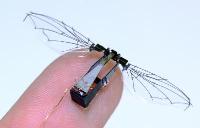
Micro Air Vehicles May Someday Detect Environmental Hazards
Dr. Robert Wood of Harvard University is leading the way in what could become the next phase of high-performance micro air vehicles for the Air Force.
His basic research is on track to evolve into robotic, insect-scale devices for monitoring and exploration of hazardous environments, such as collapsed structures, caves and chemical spills.
"We are developing a suite of capabilities which we hope will lead to MAVs that exceed the capabilities of existing small aircraft. The level of autonomy and mobility we seek has not been achieved before using robotic devices on the scale of insects," Wood said.
Wood and his research team are trying to understand how wing design can impact performance for an insect-size, flapping-wing vehicle. Their insights will also influence how such agile devices are built, powered, and controlled.
"A big emphasis of our AFOSR program is the experimental side of the work," Wood said. "We have unique capabilities to create, flap and visualize wings at the scales and frequencies of actual insects."
The researchers are constructing wings and moving them at high frequencies recreating trajectories similar to those of an insect. They are also able to measure multiple force components, and they can observe fluid flow around the wings flapping at more than 100 times per second.
Performing experiments at such a small scale presents significant engineering challenges beyond the study of the structure-function relationships for the wings.
"Our answer to the engineering challenges for these experiments and vehicles is a unique fabrication technique we have developed for creating wings, actuators, thorax and airframe at the scale of actual insects and evaluating them in fluid conditions appropriate for their scale," he said.
They are also performing high-speed stereoscopic motion tracking, force measurements and flow visualization; the combination of which allows for a unique perspective on what is going on with these complex systems.